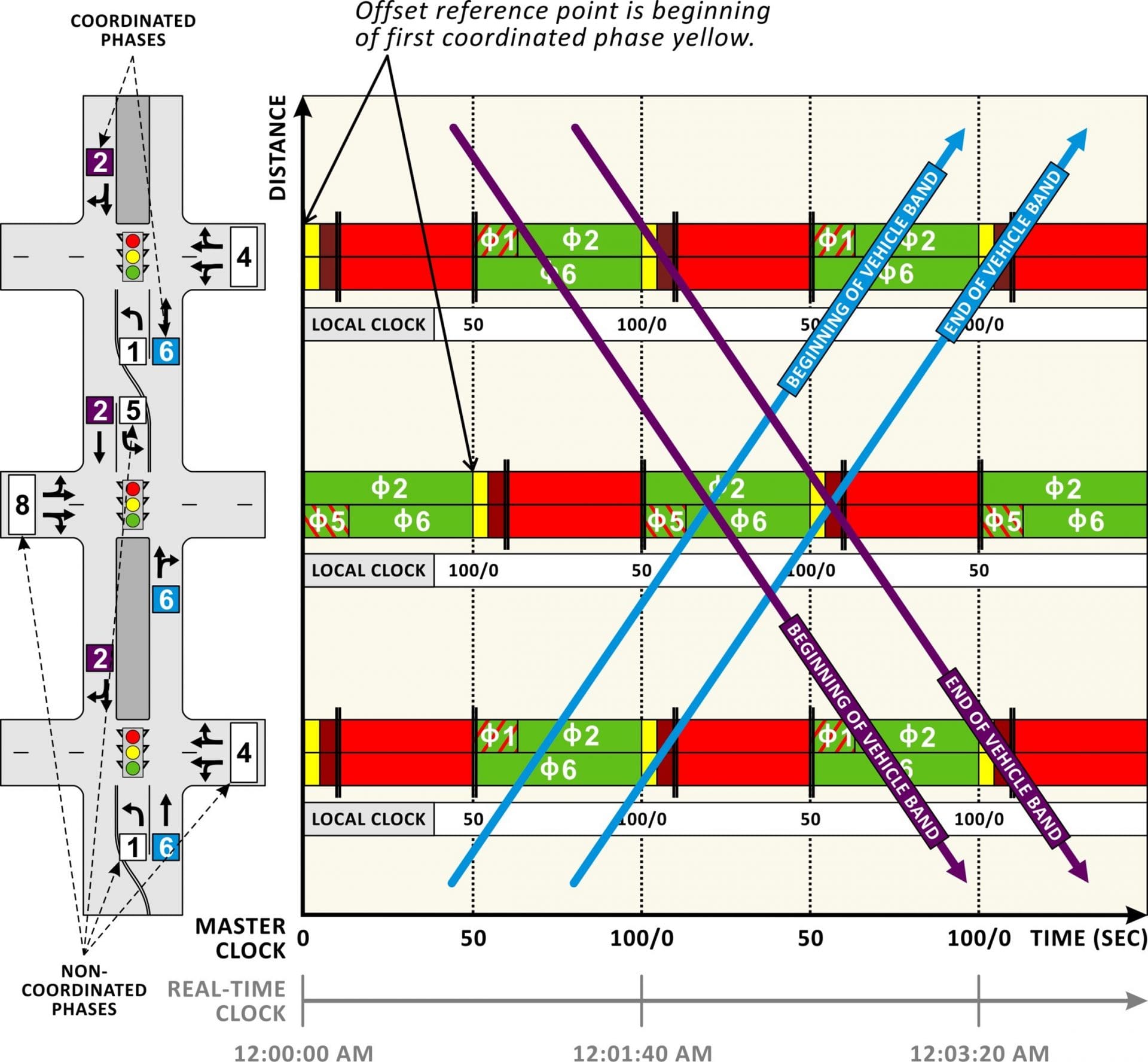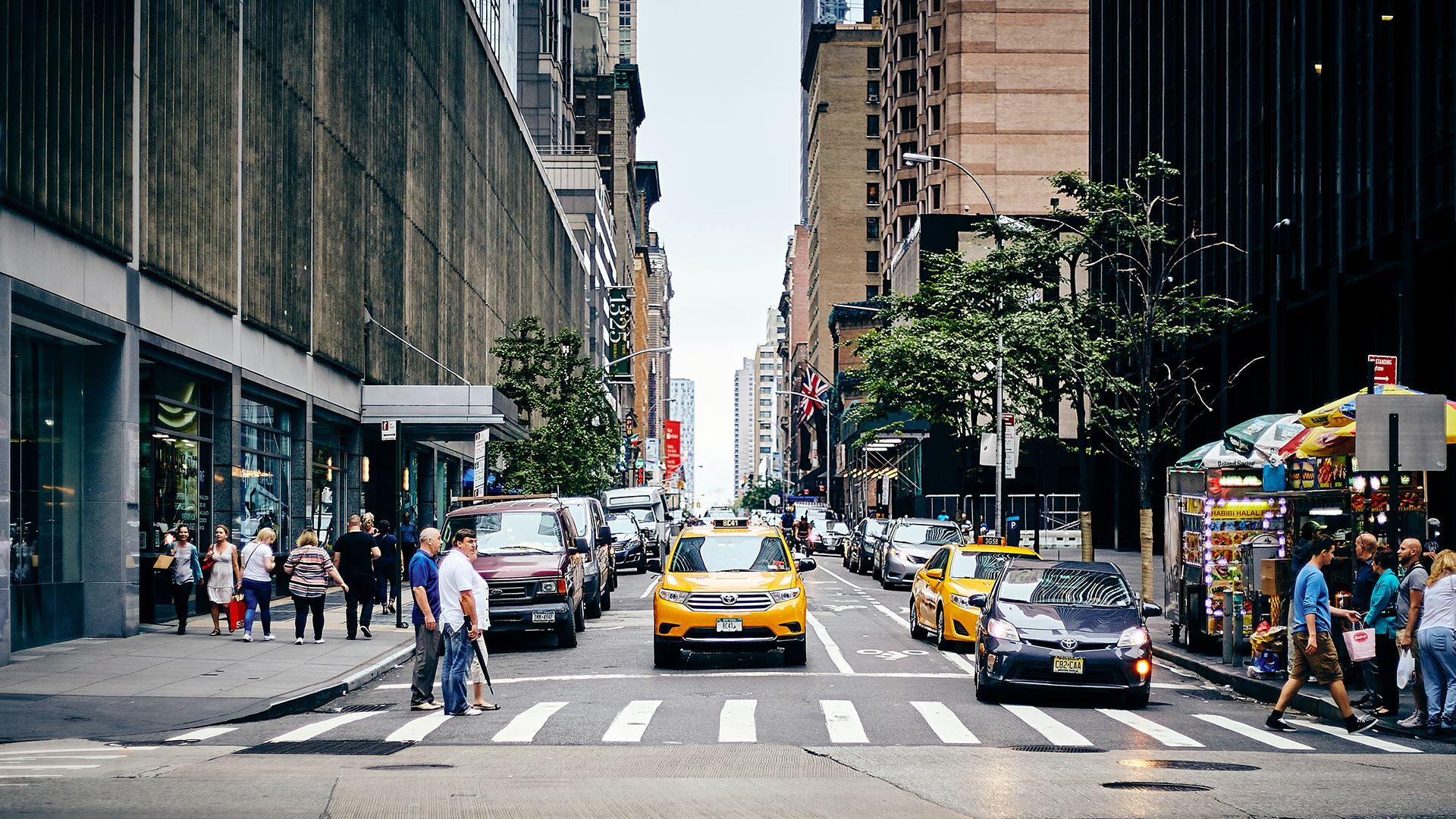October 15, 2021
As transportation professionals, we’re often faced with the challenge of providing additional roadway capacity to reduce traffic delays without increasing the roadway footprint to minimize construction and environmental costs. One way we seek to do this is improving the efficiency of traffic signals to ensure more effective use of existing roadway capacities for vehicles.
Signal coordination is a common signal timing strategy utilized in the U.S. to improve roadway operations for vehicles primarily moving long distances. When you’ve had the good fortune of hitting several green lights in a row as a driver, you’ve benefited from signal coordination. Signal coordination typically uses a common cycle length and synchronizes multiple intersections with the goal of reducing number of stops and delay for through traffic, as shown here with ideal spacing and uniform intersections.

Signal coordination typically uses a common cycle length and synchronizes multiple intersections with the goal of reducing number of stops and delay for through traffic.
Under certain roadway and traffic conditions, signal coordination can be a very effective strategy in reducing delays and stops for drivers, increasing the overall vehicle efficiency of a corridor. However, as the number of signals increases, coordination becomes more challenging and less effective in reducing vehicle delay and stops. Furthermore, signal coordination also has substantial limitations and its impact on pedestrians, bicycles, and transit is not often recognized.
In this article, we summarize the benefits and limitations of signal coordination with all roadway users in mind.
Signal Coordination Benefits
Along one-way arterials and when intersections operate below capacity, signal coordination can be extremely powerful, providing progression and eliminating stops over multiple signals, resulting in near-zero delay for through vehicles regardless of intersection cycle length. As an example of this, if you have ever driven on First or Second Avenue in Manhattan, New York, you’ve likely been amazed how it is possible to go through 50 intersections without stopping!

Signal coordination can make it possible to go through 50 intersections in Manhattan, New York without stopping.
On two-way arterials, progression can be provided in both directions if intersection spacing is such that travel time between intersections equals a multiple of half the cycle length. Where intersection spacing is not ideal, agencies typically find a compromise between the two directions or prioritize the direction that is the dominant direction of flow. Sometimes agencies also employ lead-lag left turn phase sequence strategy to help improve progression quality on two-way arterials when spacing is not ideal.
According to an article in IEEE Transactions on Vehicular Technology, previous studies have shown that depending on the prior method of signal control, traffic flows, and road layout, signal coordination can reduce delays and stops by 10 and 40 percent.
Signal Coordination Limitations
Even though signal coordination can significantly improve vehicle traffic operations, it also has important limitations, not only for pedestrians, bicycles, and transit, but also for vehicles. Too often, cycle length is increased to provide coordination between many intersections with different spacing and traffic volumes, resulting in significant negative effects on some vehicles and other roadway users.
Long Cycle Lengths
Maintaining signal coordination requires using a common cycle length at intersections, even if varying over time in some adaptive systems. Typically, coordination cycle length is governed by a single critical intersection that forces all other intersections to adopt a longer cycle length. This is not a problem for traffic that benefits from coordination; however, for other road users such as turning traffic, cross-street traffic, pedestrians, bicycles, and often transit (more on that later), longer cycle lengths mean longer delay. While coordination is also possible with half-cycle lengths (also known as double cycling), we should note that achieving half cycle lengths occurs very rarely because it requires big differences in natural cycle lengths, which is not very common along arterials, especially when minimum pedestrian green times are considered.
In addition to increased vehicle delay for non-through vehicles, long cycle lengths also have safety implications. Research has shown that short cycle lengths reduce waiting time for pedestrians, which improves compliance and safety. Additionally, a 2018 study showed that long cycle lengths and coordination zones can incentivize drivers to speed.
Not Every Vehicle Is Traveling End-to-End
Signal coordination along a corridor typically assumes the majority of vehicles travel from one end of the corridor to the other end. While this can be true for some of the commuter routes that are primarily served as a “through” corridor, other corridors may serve as major activity centers and a destination with many vehicles traveling only a few intersections along an arterial before making a turn. This reduces the benefits of signal coordination and increases vehicle delay because signal coordination requires longer cycles.
A study that Kittelson & Associates is leading for MetroPlan Orlando in Florida provided interesting insights into this issue. Data collected from 17 different arterials with varying corridor lengths (one mile to 12 miles) and number of intersections (five to 18 intersections) showed that when aggregated over all 17 arterials, only about 10 percent of the vehicles travel from end-to-end. The graph below shows how the percent of demand that travels from end-to-end vary with the number of intersections along a corridor and indicate that after about six intersections, less than 15 percent of the vehicles travel for the entire length of the corridor.

A study from Metroplan Orlando showing percent demand that travels from end-to-end under varying numbers of intersections along arterials.
Another study conducted in Washington, D.C. along Georgia Avenue NW came to similar conclusions. StreetLight data indicated that vehicle trips that start and/or end on the corridor are six times greater than the vehicles traveling end-to-end.
Inability to Accommodate Transit
There is a general perception that signal coordination and long mainline green durations also benefit transit. However, unlike vehicles, most buses make frequent stops along arterials to serve their passengers, and therefore cannot follow the progression speed that is typically designed for vehicles. When this happens, it takes longer for buses to get back into coordination due to the long cycle lengths. Longer cycle lengths also increase delay for buses that are not on the mainline (e.g., making a turn to/from side street or on cross street).
Another limitation of signal coordination for buses is its effect on transit signal priority (TSP). Due to the need to maintain a common cycle length for signal coordination, coordinated intersections offer little flexibility to respond to and recover from TSP interruptions, especially under high congestion. When a TSP request is granted for congested intersections, the process used to recover signal coordination after TSP is granted can lead to transitions and capacity shortfalls. This typically results in agencies not implementing TSP at congested intersections where buses experience high delays and therefore need the most help. Instead, TSP is often considered only at intersections with low congestion levels where it may be of little help since bus delay is not that high in the first place.
Bicyclists Unable to Follow Progression Speed
Like transit vehicles on arterials, people who bike are typically unable to follow the progression speed designed for vehicles, as average bicyclist speeds are approximately 10-12 mph, with 85th percentile speeds around 15 mph. This typically leads to bicyclists making multiple stops at intersections, increasing their delay due to long cycle lengths.
To overcome this issue, a few cities in the U.S time their signals using lower progression speeds, especially on urban arterials with heavy bicyclist activity. However, the idea of using lower progression speed to incorporate bikes is still uncommon in the U.S. and only applied by a few agencies.
Limited Flexibility to Respond to Vehicle Demand Variations
Often, traffic signals are timed using a few days of traffic count data that may poorly capture vehicle demand variations. This is especially a problem for coordinated intersections as they need to maintain a common cycle length that can’t go up or down to respond to actual traffic. This limited flexibility makes coordinated signals poorly suited to respond to vehicle demand variations, resulting in inefficient operation when vehicle demand varies a lot or is unpredictable. Coordinated-actuated signals offer some flexibility, especially for the coordinated phases, but still suffer from the limited flexibility and the need to maintain a common cycle length.
Keep All Users in Mind and Don’t Treat Coordination As “Sacred”
Signal coordination can be an effective timing strategy that reduces vehicle delay and stops on arterials, but it also has major drawbacks for other roadway users. Often, the benefits of coordination are assumed to be applicable at virtually all intersections and under virtually all conditions. However, it’s problematic to assume that coordination over long stretches of roadways is the best operation, since in reality it may be detrimental to all classes of roadway users (car and truck drivers, bus riders, pedestrians, and bicyclists).
Ultimately, when timing signals, traffic engineers should first identify the primary users of a corridor and understand its characteristics and user priorities before making decisions related to signal coordination (either the extent of signal coordination or whether to coordinate intersections or not).
If you are interested in this subject and would like to discuss further, please feel free to contact us!
References
Exploring Ped Responsive Timing Strategies
Signal Timing Manual, 2nd Edition
Optimizing Networks of Traffic Signals in Real Time – The SCOOT Method
Using Traffic Signal Control to Limit Speeding Opportunities on Bidirectional Urban Arterials
